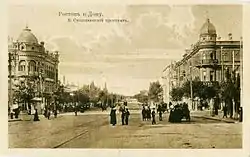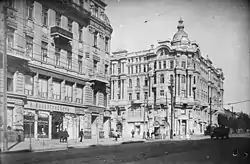Chernov House
The Chernov House (Russian: Дом Чернова, tr. Dom Chernova) is an edifice in the Kirovsky District of Rostov-on-Don, Russia. The house is located at 69 Bolshaya Sadovaya street (Russian: Большая Садовая, 69) at the intersection of Voroshilovsky avenue and Bolshaya Sadovaya street. It was a revenue house. The building is also considered to be an object of cultural heritage.[1]
%252C_69(2).JPG.webp)
History


The Chernov House was built in the 1890s by order of Rostov merchant Karapet Chernov. Originally the building had only three stories but, due to incipient housing boom in Rostov-on-Don, number of storeys was increased to five floors upon to a project of Rostov architect F. S. Jasinsky and engineer G. G. Chorchopyan. An urban legend originated from the construction of the building. Two merchants allegedly made a bet who which one of them are richer. They decided to build the revenue houses as luxurious as possible on Bolshaya Sadovaya street across from each other.[2] In the end, however, Melkonov-Yezenkov House was higher than the Chernov House through the availability of the dome on the roof.[3]
Dwellings in the Shirman House were rented. Before the revolution of 1917, Saint Petersburg International Commercial Bank, Merchant mutual loan society, agricultural bank and dentist M. M. Sabsovich occupied the ground floor. The building was nationalized after the establishment of the Soviet rule in 1920. The upper floors were turned over to Dinamo sports club, Palace of Labour and other organizations. In 1931, the Chernov House was turned over to Institute of Economics and Finance. The building was badly injured during the Second World War.[4] It was restored upon a project of architects M. N. Inushnin and G. A. Petrov. An original appearance was subsequently partially lost. The building had lost the balustrade on the roof.[3]
Institute of Economics and Finance was renamed Institute of national economy in 1964. The Rostov State University of Economics occupies the Chernov House currently.[3]
Description
The five-storey building was designed in the Art Nouveau style in the end of the 19th century. The facade is decorated with Corinthian and Ionic twin pilasters, wreaths, escutcheons, casings, garlands, lion masks, attic, and floral ornament. The first and second floors are decorated with banded rustications. The fifth floor has small balconies with delicate iron-cast railing.[3]
References
- "Памятники регионального значения, находящиеся на учёте в Администрации Ростовской области на 1 января 2009г". voopiik-don.ru. Retrieved 2013-09-04.
- "Ворошиловский проспект (а также Столыпина и Карла Маркса)". Archived from the original on 2019-03-26. Retrieved 2019-11-05.
- Черницына В. А., Есаулов Г. В. (2002). Архитектурная летопись Ростова-на-Дону. Rostov-on-Don. pp. 98–101. ISBN 5-8456-0489-3.
- "Осколки прекрасного". rostov-dom.info. Retrieved 2017-11-14.